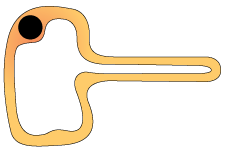Miss K is introducing specialised cells to her mixed set Year 7 class. She is starting with the root hair cell. Before she explains where it is found and what it does, she notices the class looking bored, almost glassy-eyed. So, pointing to the picture of the root hair cell, she asks them: Which Mr Men character does this cell remind you of?

The class look confused. One student gingerly puts their hand up to guess at ‘Mr Tickle’ but Miss K tells them it is Mr Nosey.

Miss K goes on to say that just like Mr Nosey, root hair cells have a long structure that looks like a nose. ‘Now, this sturcture doesn’t actually behave like a nose- it cannot smell. But it gives the cell a larger surface area. Why do we think this cell needs a larger surface area?’ She pauses for a couple of seconds.
‘It helps the cell complete its function. What function is that….Emily?’
Emily looks at her teacher blankly as Miss K walks over to a sink near her and turns on the tap. Emily whispers ‘to get water?’ and Miss K repeats that answer loudly for the rest of the class to hear. Miss K then summarises to the class: ‘So, the root hair cell has a larger surface area by having this structure so it can absorb more water from the soil.’
They then move on to the next specialised cell.
There would be a time when I would consider the above sequence to be evidence of good teaching.
- the teacher notices the class losing focus so she brings them back with a completely different example
- she is using Cold Call with thinking time
- she is providing cues without giving the actual answer away when students struggle to answer a question
- she summarises this part of the lesson with an important fact that students need to remember
Cold Calling, thinking time, providing cues, summarising are all good things to do when teaching. But where and how we use them matters.
Taking the scenario above further:
A few weeks later, the class has to complete an assessment on cells. A question on the root hair cell is inevitably included. Here is a sample of the answers Miss K reads through:
root hair cells have a large surface area to take in water
root hair cells have a nose to suck in water
the cell looks like mr nosey because he has a long bit sticking out
the cell has a larger surface area to absorb water from soil
dunno
Miss K is pleased to see some of her students have remembered that root hair cells have a large surface area and that they absorb water. She is annoyed at the ones who have written about noses but thinks that as some students got the correct answer, the others don’t really have an excuse.
When she returns the assessments, Miss K chides the class for writing about noses or bits sticking out instead of giving the right answer, which she was clear to provide during her explanation.
Would those students have written about Mr Nosey or noses if Miss K had never mentioned Mr Men?*
I have certainly done this in my own teaching before. I have given an example or made a funny comparison to something that shifts attention away from the actual content to something completely irrelevant.
I have previously written about the dangers of going off on tangents when narrating stories during teaching but we need to be just as careful with our examples and analogies. Ask yourself these questions before using a trick to help students remember something better:
- does it have any similarities that are relevant to the content?
- does it have differences to the content that can be explained easily?
- does it detract from the actual focus of the content?
In the case of Mr Nosey:
- does it have any similarities that are relevant to the content?
- none except for the shapes
- does it have differences to the content that can be explained easily?
- no. Mr Nosey uses his nose for, well, nosey things, while the root hair cell uses the protruding structure to absorb more water
- does it detract from the actual focus of the content?
- yes, it detracts from learning about root hair cells as besides the shapes, there is nothing else in common
We need to choose wisely when using examples and tricks and cues in teaching. Otherwise the things we say to make the content seem interesting become the focus, instead of the content itself.
* there are other points of improvement within the short scenario mentioned here but those are not the focus of this post.